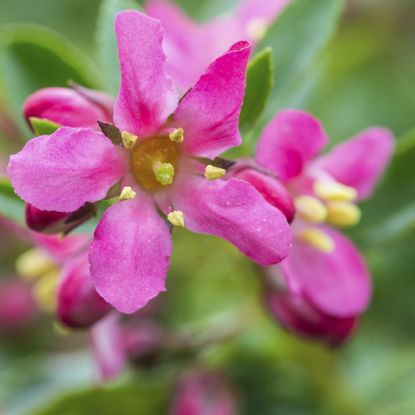Escallonia Shrub Info: Tips On Growing An Escallonia Hedge


Escallonia shrubs are versatile shrubs, perfect for a flowering hedge or specimen planting. This is an exceptional evergreen, thanks to its fragrance. The glossy green leaves offer a pungent aroma while the flowers have a light, sweet smell. Caring for escallonias is not difficult. Read on for escallonia plant care information.
Escallonia Shrub Info
Escallonia shrubs grow relatively fast and have both attractive foliage and lovely flowers. The blossoms are tube-shaped, generally white, pink or red, and appear on leafy panicles in summer. Plants can grow to 15 feet (4.5 m.) in either direction, depending on the cultivar. Since escallonia is tolerant of salt spray, you can start growing an escallonia hedge even if you live in coastal areas. Escallonia also makes an attractive garden specimen when planted with plenty of elbow room. Plant this shrub in U.S. Department of Agriculture plant hardiness zones 8 through 10.
How to Grow Escallonia Shrubs
You may be wondering how to grow escallonia shrubs. Despite their lovely, delicate flowers, escallonias are self-sufficient shrubs that grow without much maintenance if planted appropriately. If you read up on escallonia shrub info, you will find that the plants do best in full sun in well-drained soil. In hot climates, caring for escallonias is easier if you plant the shrubs in partial shade. Select a location to plant escallonia shrubs where they are protected from chill winds. If you are growing an escallonia hedge, plant the shrubs closer together than for specimen planting. These plants are not expensive and, if you have patience for a few years after planting, you will have a lovely hedge.
Caring for Escallonias
When it comes to escallonia plant care, don’t think you will have to invest many hours meeting this shrub’s needs. Generally, well-planted escallonia shrubs do not require maintenance. For example, escallonias do not require pruning to keep them healthy, but they accept pruning. If yours are looking too big for their garden location and you decide to prune, shear them lightly in summer after flowering is done for the season. To reduce the size of big shrubs, you can remove up to 1/3 of the old wood just after the plant blossoms. If you have read some escallonia shrub info, you know that the plant is full of buds in spring. If you prune in spring, you’ll drastically reduce the numbers of flowers on the plant. Caring for escallonias involves providing regular irrigation during dry periods. This helps keep the shrubs healthy and filled with flowers.
Gardening tips, videos, info and more delivered right to your inbox!
Sign up for the Gardening Know How newsletter today and receive a free download of our most popular eBook "How to Grow Delicious Tomatoes."

Teo Spengler has been gardening for 30 years. She is a docent at the San Francisco Botanical Garden. Her passion is trees, 250 of which she has planted on her land in France.
-
 Urban Beekeeping Guide: Top Tips For Raising Bees In The City
Urban Beekeeping Guide: Top Tips For Raising Bees In The CityUrban beekeeping can be a rewarding and appreciated pastime, but first be sure it’s legal in your city and learn the ropes of beekeeping.
By Mary Ellen Ellis
-
 2024 Plant Of The Year: Why Experts Say Philodendron Is The “It” Plant Of The Year
2024 Plant Of The Year: Why Experts Say Philodendron Is The “It” Plant Of The YearWe aren’t surprised that philodendron was designated the plant of the year. Versatile, easy-care and lovely, it’s the houseplant of the year 2024!
By Bonnie L. Grant